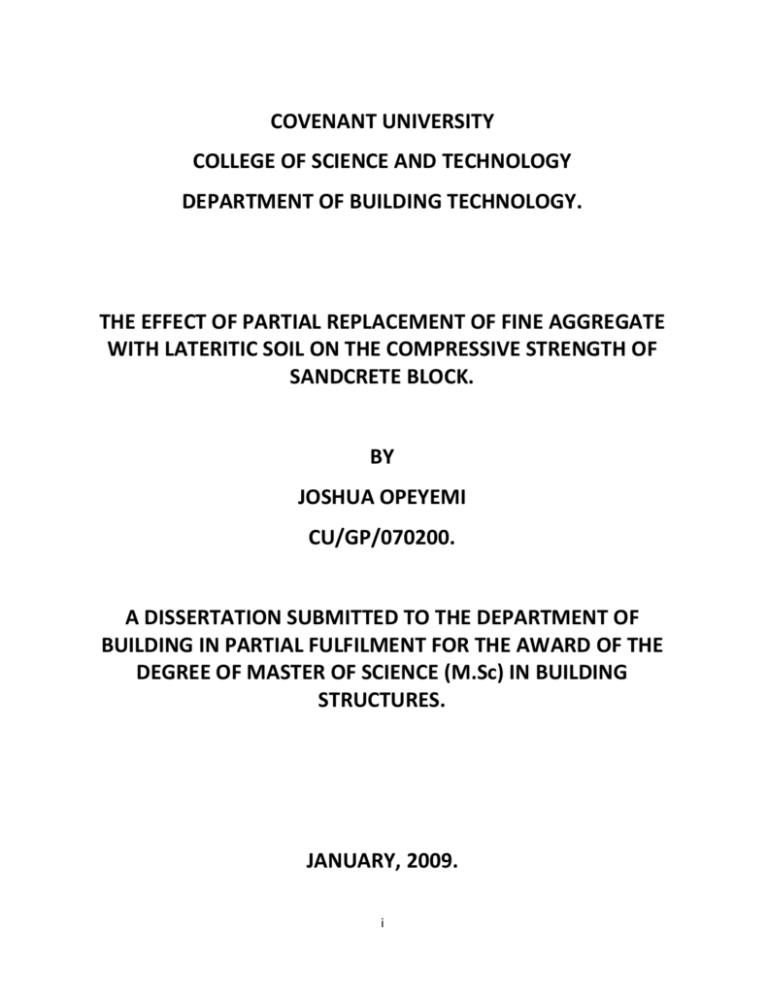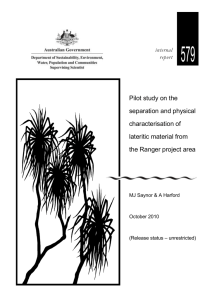- Covenant University Repository
advertisement

COVENANT UNIVERSITY COLLEGE OF SCIENCE AND TECHNOLOGY DEPARTMENT OF BUILDING TECHNOLOGY. THE EFFECT OF PARTIAL REPLACEMENT OF FINE AGGREGATE WITH LATERITIC SOIL ON THE COMPRESSIVE STRENGTH OF SANDCRETE BLOCK. BY JOSHUA OPEYEMI CU/GP/070200. A DISSERTATION SUBMITTED TO THE DEPARTMENT OF BUILDING IN PARTIAL FULFILMENT FOR THE AWARD OF THE DEGREE OF MASTER OF SCIENCE (M.Sc) IN BUILDING STRUCTURES. JANUARY, 2009. i CERTIFICATION. This is to certify that this dissertation was undertaken by Joshua Opeyemi and meets the requirement for the award of Master of Science Degree (M.Sc) in Building Structures in the Department of Building Technology, Covenant University, Ota. Nigeria. Professor J. B. Adeyeri. ______________________________. Project Supervisor. Signature and Date. Professor T. O Mosaku. ______________________________. Head of Department. Signature and Date. EXTERNAL SUPERVISOR. ______________________________. Signature and Date. ii DEDICATION. Firstly to the almighty God and secondly to my Late Father, Mr T. E. Joshua. iii ACKNOWLEDGEMENT. Is there anything a man have that he is not given? On this note, I sincerely appreciate the almighty God for this award that He is giving me and the grace He has given me to complete my Masters’ programme despite my imperfections and shortcoming, He has proven Himself faithful and I return every Glory back to Him. Words alone cannot just express how much inspirations from an inexhaustible source tapped from the Chancellor which has been a great source of push and encouragement during the course of this work and to life in general. May the almighty God grant him the divine wisdom to lead this noble institution to an unimaginable height in Jesus Name. I want to use this opportunity to appreciate the Management of Covenant University for her support and investment on me which I consider a rare privilege and by God’s grace, I will put in the best of my efforts to see that this investment is justified. I pray that the Lord will strengthen her to realise the Institution’s vision. Special appreciation goes to the Dean, College of Science and Technology in the person of Professor James Katende for his backings and support that accelerated the programme. My prayer for you sir is that God will also send you an unusual help in your times of need. Amen. Special appreciation goes to the father of Building and my Head of Department in the person of Professor T. O. Mosaku for his encouragement to see that I continue in this field despite my considering opting out for another and I am glad he did encourage me to continue in my area of passion. Also I extend my sincere appreciation and a big thank you to the other members of the Department in the persons of Dr G. L. Oyekan, Dr Fagbenle, Dr Kuroshi, Dr Olusola (OAU), Mr Ogunde and his Lovely family, Mr Amusan and Mr Anosike. May the Lord reward every area of their endeavours in Jesus Name. Big appreciation goes to my supervisor in the person of Prof J. B Adeyeri for his simplicity, precious time spent despite all other highly demanding commitments and immense contribution to this work. May the Lord reward you in Jesus Name. To my Mummy, Mrs E. Joshua; uncle, Mr S.T Joshua and all my siblings and other family member, I say a bit thank you for the sense of belonging gotton from you. God bless you all. To my friends like Obande P., Umezinwa C., Omuh I., Adelakun A., the Kukoyi’s and the rare and closest of them, Igbinoba A.O., I really appreciate her support both in time and resources. God bless you all. In conclusion, God bless you all. Amen. iv TABLE OF CONTENT. Content Page. Title page. ............................................................................................................... i Certification. ........................................................................................................... ii Dedication. .............................................................................................................. iii Acknowledgement. .................................................................................................. iv Table of content. ...................................................................................................... v List of Tables. ............................................................................................................ x List of figures. ............................................................................................................ xi Abstract. .................................................................................................................... xii CHAPTER ONE. 1.1 Introduction. .......................................................................................... 1 1.2 Aims and Objectives. .............................................................................. 2 1.3 Research Methodology. ................................................................ ....... 3 1.3.1 Block Production. ................................................................. ....... 4 1.3.1.1 Materials. ........................................................................ ....... 4 1.3.1.2 Batching and Mixing. ...................................................... 4 1.3.1.3 Moulding of the sandcrete block. ................................... 6 1.4 Curing. ......................................................................................... 7 1.5 Study Justification. ........................................................................ 7 CHAPTER TWO. 2.0 Literature Review. ....................................................................... 8 2.1 Previous works on laterised blocks. ........................................ 8 v 2.2 BLOCKS AND BLOCKWORK. ........................................................ 9 2.2.1 Sandcrete Blocks. ....................................................... 9 2.2.1.1 Material and Dimension. ............................... 9 2.2.1.2 Pre-Cast Sandcrete Blocks. …………………………… 10 2.2.1.3 Mix Proportions. ………………………………………… 10 2.2.1.4 Strength Requirements. ……………………………… 10 2.2.1.5 Moulding and Compaction. ………………………… 10 2.2.1.6 Production/Processing. ………………………………. 10 2.2.1.7 Curing …………………………………………………………. 11 2.3 Properties of Block. …………………………………………………………….. 11 2.3.1 Strength. …………………………………………………………………. 11 2.3.2 Thermal Insulation. ………………………………………………….. 11 2.3.3 Acoustic Property. …………………………………………………… 11 2.3.4 Fire Resistance and Durability. ……………………………….. 12 2.3.5 Water Absorption and Effect of Admixture of Sand….. 12 2.4 Introduction to lateritic soil. 2.5 Review of Nomenclature on Lateritic Soils. ........................... 13 2.6 Genesis and Evolution of Laterites/ Lateritic Soils. ................ 16 2.6.1 Physical Weathering of Rocks. ................................... 17 2.6.2 Chemical Weathering of Primary Minerals. .............. 17 2.6.3 Accumulation of Sesquioxides in Laterite/Lateritic Soils. 18 2.6.4 Evolution of Lateritic Soils. ................................................ 20 2.7 The Structural Development of Laterite Soils. ..................... ......... 22 2.7.1 Morphological Change. ............................................. 22 vi 2.7.2 Chemical and Mineralogical changes. .................. 22 2.7.3 Leaching of Dissolved Substances. ........................ .......... 24 2.7.4 Sesquioxide Coatings of Fine Particles. ............................ 25 2.7.5 Formation of the Concretionary Structure. ................ 26 2.7.6 Dehydration of Sequioxides and Secondary Minerals. 27 2.4.7 Sesquioxides in the Induration of Laterite Materials. . 28 2.8.0 LOCATION OF LATERITIC SOILS. .............................................. 28 2.8.1 Parents Materials. ........................................................ 29 2.8.2 Climate. ......................................................................... 30 2.8.3 Vegetation. ............................................................. ......... . 31 2.8.4 Topography and Drainage Conditions. ........................... 32 2.8.5 Geological Time Factor. ............................................... 33 2.9 MORPHOLOGY AND COMPOSITION OF LATERITE SOILS. ............ 2.9.1 Characteristics of Lateritic Soil Profile. ....................... 34 34 2.9.1.1 Soil Layer Overlying Lateritic Bed. ..................... 34 2.9.1.2 Lateritic Horizon. ............................................... 35 2.9.1.3 Soil Layers below Lateritic Horizon. .................. 35 2.9.2 Morphological characteristics. ...................................... 35 2.9.2.1 Genetic-textural characteristics. ...................... 38 2.9.2.2 Colour. .............................................................. 38 2.9.2.3 Macro-structure. .................................................. 38 2.9.2.4 Origin and state at excavation. ........................ 39 vii 2.9.2.5 Relation to parent rock. ....................................... 39 2.9.3 Chemical characteristics. .................................................. 39 2.9.4 Mineralogical Characteristics. ....................................... 40 2.10 Soil Classification System. ………………………………………………… 43 2.10.1 Unified Soil Classification System (USCS)....................... 43 2.10.2 Soil Classification Tools. .................................................. 44 2.10.3 Properties of a Well Graded Soil. ..................................... 46 CHAPTER THREE. 3.0 MATERIALS, SPECIMENS, PREPARATION AND EXPERIMENTAL DETAILS. 3.1 Block Moulding. ......................................................................... 48 3.2 Preparation of disturbed samples for testing. .............................. 48 3.3 Determination of Moisture Content (Oven Drying Method). ...... 48 3.4 Atterbergs Limits Test. ....................................................... ......... 48 3.5 Grains-Size Analysis. ................................................................... 48 3.6 Specific Gravity Test. ............................................................... 48 3.7 Soil Compaction Test. …………………………………………………………… 48 3.8 Compressive Strength Test. ………………………………………………….. 49 CHAPTER FOUR. 4.0 PRESENTATION AND DISCUSSION OF RESULTS. ............................ 50 4.1 Block Moulding Observations. ......................................................... 50 4.2 Atterberg Limits’ Test Result. .......................................................... 50 viii 4.2.1 Liquid limits test results. .......................................................... 50 4.2.2 Plastic Limit Test Results. ........................................................... 51 4.3 Grain Size Analysis Result (Gradation). .................................................. 52 4.3.1 Sieve Analysis Test Results. ........................................................ 52 4.3.2 Hydrometer Test Results. ......................................................... 53 4.4 SPECIFIC GRAVITY TEST RESULT. ............................................................ 55 4.5 Bulk/Dry Density Test Result. ................................................................. 55 4.6 Compressive Strength Test Results. ...................................................... 59 CHAPTER FIVE. 5.0 CONCLUSIONS, LIMITATIONS AND RECOMMENDATION. ……………… 61 5.1 Conclusion. ……………………………………………………………………………………. 61 62 62 5.2 Limitations. ……………………………………………………………………………………… 5.3 Recommendations for further studies. ……………………………………………… BIBLIOGRAPHY. ………………………………………………………………………………………..… 63 APPENDICES. ............................................................................................... ix 70 LIST OF TABLES. 2.1 SUMMARY OF CHARACTERISTICS OF ALUMINOUS AND FERRUGINOUS LATERITIC SOILS. .... 15 2.2 Generalized Morphological Characteristics of Materials from Lateritic Profile. . 36 2.3 The Chemical composition of laterite materials from various parts of the world.37 2.4 Influence of weathering condition on the mineralogy of typical tropical soil. ... 41 4.1 Liquid Limit Results. .............................................................................. 50 4.2 Plastic Limits Results. ................................................................................... 51 4.3 Sieve Analysis Results..................................................................................... 52 4.4 Hydrometer Results........................................................................................... 53 4.5 Coefficient of Curvature/ Uniformity readings................................................... 54 4.6 Specific Gravity Result........................................................................................ 55 4.7 Soil Compaction Result. .................................................................................... 56 4.8: Compressive Strength Results. ........................................................................ 59 x LIST OF FIGURES. PAGE 2.1 Structural Development of Lateritic Soils. ..................................... 16 2.2 Chemical and mineralogical characteristics of laterite weathering. 18 2.3 Solubility of hydrated hydroxides and silica in relation to PH......... 19 2.4 Cycle of weathering and laterization process. ............................... 21 2.5 Change in chemical composition at various stages in the formation of aluminous lateritic rock. .......................................... 23 2.6 X-Ray diffraction patterns of the coarse clay fraction of lateritic soil... 25 2.7 The influence of Iron oxide content on the strength of concretory aggregate. ................................................. 26 2.8 Simplified geological map of West Africa. ...................................... 29 2.9 Weathering Sequence of Basaltic lavas in relation to weathering conditions. ........................................ 30 2.10 Morphological characteristics of laterite profile in relation to vegetation cover. ................................................. 31 2.11 Soil and slope relationship in south west Nigeria. ....................... 33 2.12 A typical lateritic profile. ............................................................. 40 2.13 Chemical composition of laterite material. ................................. 41 2.14 Casagrande’s plasticity chart showing several representative soil types developed from (Casagrande, 1948). .... 44 2.15 Auxiliary Laboratory Identification Procedure. .............................................. 45 2.16 Typical grain size distribution curves. …………………………………………………. 46 xi ABSTRACT. This work seeks to find a way in which lateritic soil within Ota, Ogun State of Nigeria could be use in the production of hollow sandcrete blocks. This replacement is intended to observe the effect of lateritic soil on the strength characteristic when employed in the production of sandcrete blocks. It was deduced from past works that the inclusion of lateritic soil in sandcrete block production will produce a lesser quality blocks but this work seeks to find the maximum permissible replacement that will still make the blocks be within the recommended standard. Sandcrete blocks were produced with each lateritic soil samples from different sources replacing the conventional fine aggregate, sand, in steps of ten percent (10%) to sixty percent (60%) and their compressive strengths determined and compared with that of a standard sandcrete block to check for the acceptable percentage replacement. Tests like gradation tests which include sieve analysis and hydrometer test, compaction test to determine the bulk density, Atterberg’s limit test, specific gravity test were performed on the lateritic soil samples to characterise the soils. The blocks were cured by sprinkling them with water twice daily till the twenty seventh (27th) day. In the compressive strength test, seventy two (72) numbers of 225 x 225 x 450mm hollow laterised sandcrete block sizes were produced and crushed with the compressive strength machine to determine their twenty eight-day compressive strength. Classifying the lateritic soil samples with the Unified Soil Classification System (USCS), it was found out that the lateritic soil is sandy silt of high plasticity and can replace sand by twenty percent (20%). This percentage replacement can be recommended to the block moulding industries within Ota. xii







